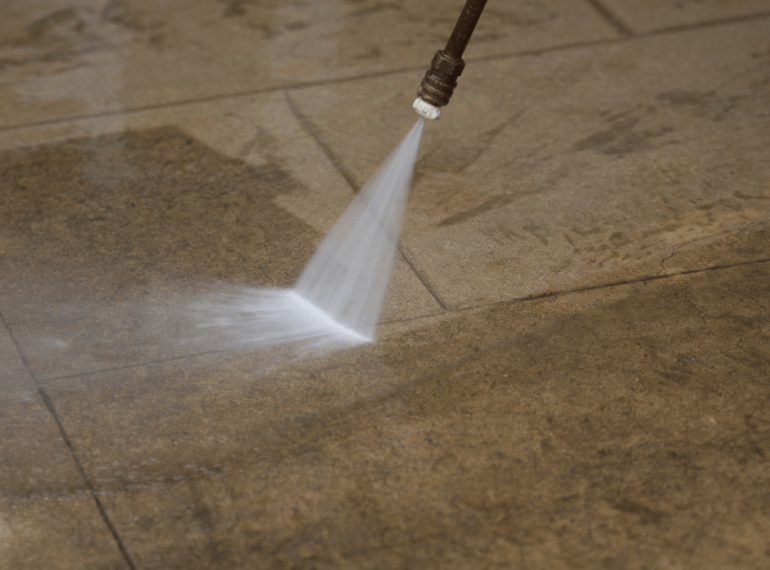
Pavers can transform any space, adding aesthetic charm to driveways, patios, and walkways. However, maintaining their pristine appearance requires a bit of careful attention. Regular cleaning is the secret to keeping your pavers in tip-top shape.
However, the challenge in cleaning pavers lies in the diverse array of paver materials and designs, making cleaning quite challenging. A power washer is one of the best ways to get the cleaning job done perfectly. In this guide, we’ll go over how to clean pavers with power washing, providing tips and techniques to ensure the enduring beauty of your pavers.
Essential Tools and Materials
Before you learn how to clean pavers with power washing, it is essential to prepare the tools and materials necessary for the job:
- Dish soap
- Water
- Spades
- Screwdrivers
- Scrub brushes
- Hose
- Broom
- Pressure water
- Bucket
- Knee pads and other protective gear
Use a paver power washer with adjustable pressure settings to suit various materials. Opt for quality detergent designed for pavers to enhance cleaning efficiency if available. Further, put on your safety gear, including gloves and goggles, before working on your property.
How to Clean Pavers with Power Washing
After gathering your tools and materials, it’s time to work on your pavers. Make sure to use your paver power washer according to manufacturer instructions. There are several recommended settings for different paver materials.
General User Guidelines and Settings
The recommended pressure setting for power washers when cleaning pavers can vary based on the material you’re working with. Here are general guidelines for different paver materials:
Concrete Pavers
- Pressure Setting: 2,000 to 3,000 PSI (pounds per square inch)
- Use a wider nozzle to distribute pressure evenly.
Brick Pavers
- Pressure Setting: 1,500 to 2,500 PSI
- Be cautious not to use excessively high pressure to prevent damage to the softer brick surfaces.
Natural Stone Pavers (Such as Limestone, Travertine, or Granite)
- Pressure Setting: 1,500 PSI or lower
- Use a wide-angle nozzle and exercise caution to avoid etching or chipping the stone.
Clay Pavers
- Pressure Setting: 1,500 PSI or lower
- Similar to natural stone, use a lower pressure to prevent damage to the softer clay surface.
Note that your specific power washer brand or model’s recommended settings may differ slightly, so check your user’s manual. It’s essential to test a small, inconspicuous area first. This will help determine the optimal pressure for your specific paver material.
In addition, always follow the manufacturer’s guidelines for the power washer and the pavers to avoid any potential damage. If the paver manufacturer provides specific recommendations, prioritize those over the general guidelines provided here.
Using Your Power Washer to Clean Pavers
Follow these steps to clean pavers efficiently:
1. Assess and Prepare the Area
Begin the process of paver pressure washing by inspecting the area for any loose debris, weeds, or other obstacles. Remove them to create a clear workspace. Cover nearby plants or delicate surfaces if possible to protect them from potential debris and detergent. Use brushes, brooms, spades, and other cleaning tools to remove loose sand, debris, dirt, and weeds.
2. Adjust Pressure Settings
As discussed earlier, ensure your power washer is set to the appropriate pressure for your specific paver material. Remember that lower pressure is ideal for softer materials like clay, while higher pressure may suit tougher surfaces like concrete. Always consult the manufacturer’s guidelines for proper guidance.
3. Pre-Rinse the Pavers
Use a garden hose to pre-rinse the pavers, which also helps to remove loose dirt and debris. This initial rinse helps to prepare the surface for the power washing process and ensures more effective cleaning.
4. Apply Paver-Safe Detergent
Load your power washer with a detergent specifically formulated for pavers, if that is available. Apply the detergent evenly across the paver surface, allowing it to penetrate and break down stains, moss, and grime. Make sure to follow the manufacturer’s instructions for the detergent application.
5. Scrub Stubborn Stains
For persistent stains, use a stiff-bristle brush to scrub the affected areas. This manual effort, combined with the power washer’s force, helps to lift and remove deep-seated grime, ensuring a thorough cleaning.
6. Power Wash in Sections
Divide the area into manageable sections. Work systematically, overlapping each pass to ensure complete coverage. Hold the paver pressure washing nozzle at a slight angle and maintain a consistent distance from the surface to avoid damage. You can also attach a 40-degree spray nozzle to your pressure wand to ensure you always spray at an angle.
The safe distance of the nozzle of a power washer from the pavement depends on the pressure of the washer and the type of surface you are cleaning. However, a general guideline is to start with a distance of about 12 to 18 inches away from the surface and adjust as needed. Further, avoid spraying too long on any spot since it can damage your pavers.
7. Rinse Thoroughly
Once the detergent has been applied and scrubbed, thoroughly rinse the pavers with the power washer. Start from the highest point and work your way downward to prevent streaking. Ensure all detergent residue is removed for a pristine finish.
8. Allow Pavers to Dry
After the power washing is complete, allow the pavers to air-dry completely. This step ensures that the cleaned surface is ready for the next phase, whether applying a sealer or simply enjoying the refreshed look of your pavers.
Work with Pavement Specialists from RedLee
With over 30 years of industry experience, Redlee/SCS stands as the go-to specialist for impeccable paver maintenance in the DFW area. Choose experience and let our specialists bring lasting vibrance to your outdoor spaces. Contact our specialists today to learn more.





